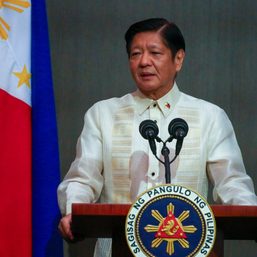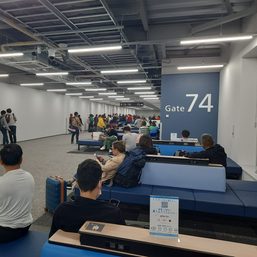SUMMARY
This is AI generated summarization, which may have errors. For context, always refer to the full article.

MANILA, Philippines – The rehabilitation project for the Philippines’ ailing main airport is now open for bidding.
The announcement, coming just about a month after the National Economic and Development Authority Board’s swift approval of the project, will see powerful private sector players competing for the contract to “rehabilitate, operate, optimize, and maintain the Ninoy Aquino International Airport (NAIA).”
In general, the P170.6-billion private-public partnership project will cover improvements to the entire airport – its runways, four terminals and other facilities. According to the Instructions to Bidders document released, the “NAIA PPP Project” will cover the following:
Construction
- Incorporation of climate adaptation measure for airfield resilience
- Rehabilitation of passenger terminals and associated facilities
- Rehabilitation of airside facilities (including runways, rapid exit taxiways/RETs, maneuvering areas, aprons, aircraft parking area, airfield lighting, etc)
- Development of adequate vehicular parking lots to cater to the public
- Development of commercial assets (assets built by the Concessionaire)
- Development of all utility systems necessary for undertaking the works
- Provision of surface access facilities that enables intermodal transfer at the airport
- Provision of inter-terminal passenger transfer facilities and services
- Connection from the Metro Manila Subway station to NAIA Terminal 3
- Overall uplift and beautification of the airport exterior and interior
Supply
- Supply and installation of all required information technology and other equipment for the proper operation and maintenance of airside and landside activities, as well as utility systems
- Supply of communications, navigation, and surveillance (CNS) systems, remote digital tower system, air traffic control (ATC) system upgrade, and airfield network and fiber upgrades
- Supply of emergency equipment
- Supply of buses for boarding transfers
Operation
- Operation of passenger terminals and related facilities
- Operation of airside facilities (including runways, RETs, maneuvering areas, aprons, aircraft parking area, airfield lighting, etc)
- Operation of Concessionaire O&M facilities and commercial assets
Maintenance
- Maintenance of passenger terminal buildings and associated facilities
- Maintenance of airside facilities (including runways, RETs, maneuvering areas, aprons, aircraft parking area, airfield lighting, etc)
- Maintenance of communications, navigation and surveillance/air traffic management (CNS/ATM) equipment
Interested bidders are also instructed to maximize “the utilization of the current airport. It may entail enhancement of operational efficiencies; use of technology; service level uplift; and expansion of facilities.”
Aside from giving technical proposals on how to upgrade the airport, bidders must also propose a revenue-sharing scheme with the government. Their bid must indicate the government’s percentage share of gross revenue, on top of an upfront payment to the Manila International Airport Authority (MIAA) of P30 billion and a fixed annual payment to MIAA of P2 billion.
The winning private concessionaire will have 15 years – with a possible 10-year extension – to implement the project and also make a return on its investment. (READ: Swift approval of NAIA rehab route triggers long, tedious paperwork)
What’s the timeline?
The pre-bid conference will be happening on September 22, 2023, which means that interested bidders have about a month from the release of the instructions to that date to prepare.
The government will be holding one-on-one meetings with prospective bidders from October 9 to 13 and again on November 6 to 10. Officials will also be conducting site visits during this time.
The bid submission date will be on December 27, 2023. From there, the government will open the bids, which have been separated in a series of envelopes, on separate dates which have yet to be announced.
Transportation Secretary Jaime Bautista previously told Rappler that it’s unlikely that a private concessionaire would be named within the year.
What are requirements for a bidder?
The bidder can be either a local or foreign partnership, corporation or consortium. They’re also required to have development experience, which in this case means they must have been an owner or concessionaire of an airport that spent at least P10 billion in cumulative capital costs.
The bidder must have taken charge of the operation and maintenance of an international airport for three consecutive years. The airport must also have had an annual passenger throughput of at least 25 million passengers per year, with at least 10 million of these being international passengers.
In terms of financial capacity, the bidder must also have a net worth of at least P20 billion as evidenced in an audited financial statement as of December 31, 2022. To participate, a bidder also has to put a non-refundable participation fee of P2.75 million.
Although its unsolicited proposal was rejected by the government, the Manila International Airport Consortium (MIAC) is still welcome to join the bidding process, according to the Department of Transportation. The consortium, however, has yet to announce any plans of joining.
MIAC consists of many of the same companies that attempted to rehabilitate NAIA during the Duterte administration: Aboitiz InfraCapital, AC Infrastructure, Asia’s Emerging Dragon Corporation, Alliance Global-Infracorp Development, Filinvest Development Corporation, and JG Summit Infrastructure Holdings Corporation. They have a new foreign technical partner – Global Infrastructure Partners – which operates several airports overseas, including the Gatwick Airport in the United Kingdom.
“Regardless of the route, we firmly believe that NAIA’s modernization requires a long-term and comprehensive solution delivered by a credible and capable party at the quickest possible time. These criteria – regardless of the approach – would best benefit NAIA and the Filipino people,” MIAC said in a statement after the government did not take on their unsolicited proposal.
– Rappler.com
Add a comment
How does this make you feel?
![[Vantage Point] Underspending left NAIA to rot](https://www.rappler.com/tachyon/2023/08/underspending-naia-august-15-2023.jpg?fit=449%2C449)

![[OPINION] Clark International Airport, one of world’s most beautiful airports, is badly underutilized](https://www.rappler.com/tachyon/2024/05/clark-airport-underutilized-may-28-2024.jpg?resize=257%2C257&crop=560px%2C0px%2C720px%2C720px)







There are no comments yet. Add your comment to start the conversation.